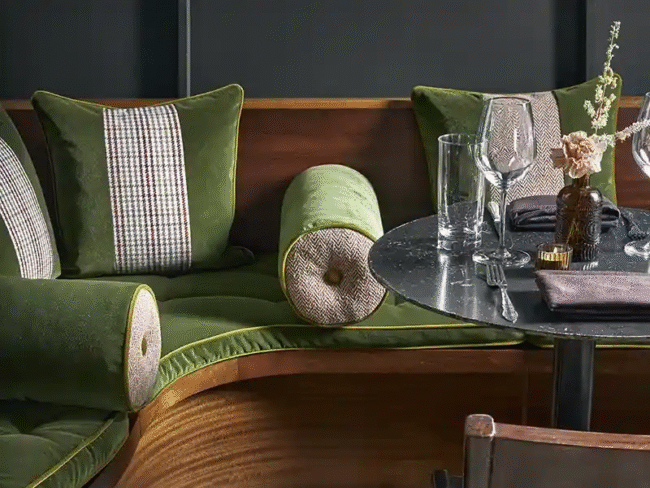
When it comes to making your bed feel inviting, the duvet cover often doesn’t get as much attention as sheets, pillows, or blankets. Yet this single item plays a big role in both the comfort of your bedding and the look of your entire room. If you’ve ever wondered what exactly a duvet cover is, how it differs from other bedding, or whether you actually need one, you’re in the right place.
This guide takes you through everything you need to know from the basics of what a duvet cover does to choosing the right fabric, design, and maintenance routine. By the end, you’ll see why this simple piece of cloth is so much more than just a decorative cover.
Understanding the Basics: What Exactly Is a Duvet Cover?
Think of a duvet cover as a giant pillow cover, but instead of holding a pillow, it has your duvet or comforter. The duvet itself is a soft, insulated insert, usually filled with down, feathers, wool, or synthetic fibers. On its own, a duvet is warm but vulnerable to stains, dust, and wear. A duvet cover acts as a protective layer, slipping over the insert and closing with buttons, zippers, or ties.
The main purpose is simple: it shields your duvet from dirt and makes cleaning much easier. Instead of struggling to wash a bulky insert every few weeks, you can just remove the cover and toss it in the laundry. But beyond functionality, duvet covers are also a style statement. Changing the cover can instantly refresh your room without buying a whole new comforter.
Duvet Cover vs. Comforter: Clearing Up the Confusion
One of the biggest sources of confusion in bedding is the difference between a duvet and a comforter. A comforter is usually a single piece: it’s quilted, filled with insulation, and designed to be used as-is. You put a top sheet underneath and a comforter on top, and that’s your bed setup.
A duvet, on the other hand, is designed to work with a cover. The cover isn’t just optional, it’s part of the setup. The duvet insert is plain white or neutral in color, while the cover adds the color, texture, and personality.
Here’s why many people prefer duvets with covers over comforters:
- its easy to clean: Comforters are harder to wash, while duvet covers can be washed regularly.
- you can play with variations: Want a new look? Swap the cover without buying a new insert.
- its long lasting: The insert stays protected, lasting for years if cared for properly.
Why You Should Use a Duvet Cover
If you’re wondering whether a duvet cover is really necessary, the answer is almost always yes. Here’s why it makes such a difference:
- Practical Protection – A duvet insert can be expensive, especially if it’s filled with natural down. The cover shields it from spills, sweat, and dust.
- Easy Maintenance – Instead of lugging your whole duvet to the laundromat, just wash the cover at home.
- Style Versatility – Covers come in endless designs, from crisp whites to bold prints. Changing one can feel like redecorating your bedroom.
- Seasonal Flexibility – Use light, breathable covers in summer and cozy flannel or sateen covers in winter.
In short, a duvet cover saves time, money, and effort while giving you freedom to personalize your space.
Fabrics to Consider: Which Material Is Right for You?
Just like bed sheets, duvet covers come in a variety of fabrics, each with its own pros and cons. Your choice depends on climate, lifestyle, and personal preference.
- Cotton – A classic choice that’s breathable, soft, and easy to care for. It works well year-round and comes in countless styles.
- Linen – Loved for its natural texture and airy feel, linen gets softer with each wash. It’s excellent for warm climates.
- Silk – Luxurious and smooth, silk covers add elegance but require delicate care. Best for those who enjoy a little indulgence.
- Microfiber – Affordable and lightweight, microfiber is wrinkle-resistant and easy to clean—a good option for busy households.
- Sateen – A cotton weave with a subtle sheen, sateen feels smooth and polished—great if you prefer a slightly more formal look.
- Flannel – Perfect for winter, flannel covers are cozy, warm, and soft against the skin.
Each fabric creates a different mood in your bedroom. For example, crisp cotton gives a fresh, hotel-like feel, while linen feels relaxed and casual.
Design and Style: How Duvet Covers Transform a Room
The design of your duvet cover often sets the tone for your entire bedroom. Because the bed usually takes up the most space, the cover acts as a centerpiece.
- Solid Colors – Neutral shades like white, beige, or gray create a clean, calming look. Bright colors can make a bold statement.
- Patterns and Prints – Florals, geometrics, stripes, or ethnic designs bring character and personality to the space.
- Texture Play – Embroidered, quilted, or jacquard designs add depth and luxury.
- Seasonal Switch – Light pastel covers in spring and summer, deeper jewel tones in fall and winter.
A duvet cover is essentially décor and bedding combined. Choosing one carefully means your room always looks pulled together without extra effort.
How to Keep Your Duvet in Place Inside the Cover
One common frustration with duvet covers is the insert shifting around inside. The good news is that many modern covers solve this with ties or snaps in the corners. You secure the insert to the cover, shake it into place, and it stays put.
If your cover doesn’t have ties, you can use duvet clips or even sew small loops into the corners. Once you try this, you’ll notice a huge difference in how neat and comfortable your bed feels.
Tips for Choosing the Right Duvet Cover
When shopping for a duvet cover, here are a few practical tips to keep in mind:
- Check the Size – Match your cover to the insert. A king-size insert needs a king-size cover for a proper fit.
- Think About Closures – Zippers keep everything secure, while buttons give a more traditional look. Ties work too, but may require adjusting.
- Prioritize Comfort – The fabric should feel good against your skin since it’s what you’ll touch the most.
- Coordinate with Decor – Choose colors and textures that work with your curtains, rugs, or wall paint.
- Consider Your Lifestyle – If you have kids or pets, go for fabrics that are easy to wash and resistant to wear.
How to Care for Your Duvet Cover
Good care keeps your duvet cover looking fresh and extends its lifespan. Fortunately, most covers are easy to maintain.
- Regular Washing – Wash everything once to twice a week to keep things clean and hygienic.
- Gentle Cycle – Use mild detergent and wash on a gentle setting to protect the fabric.
- Drying – Line-dry when possible, or tumble dry on low heat.
- Ironing or Steaming – Cotton and linen may need light ironing for a crisp finish.
- Storage – Rotate covers seasonally and store clean ones in a cool, dry place.
FAQs
Q: Do I really need a duvet cover, or can I just use the insert?
You can use the insert alone, but without a cover, it gets dirty quickly and is hard to wash. A cover makes maintenance easier and adds style.
Q: Can I use a duvet cover with a comforter instead of a duvet?
Yes, many people do. If your comforter fits inside, the cover can give it new life and protect it from wear.
Q: How often should I wash my duvet cover?
Every one to two weeks is a good rule, depending on the climate and personal preference. In warmer weather, weekly washing keeps things fresh.
Q: What size duvet cover should I buy?
Match the cover size to your insert—queen for queen, king for king. A cover that is too small will bunch, and one that is too large will feel sloppy.
Q: What’s the easiest way to put on a duvet cover?
Try the “roll method.” Lay the cover inside out, place the duvet on top, roll them together, then unroll with the cover flipped right side out. It’s quick and hassle-free.
Conclusion
A duvet cover is much more than a fabric cover for your duvet. It’s a protective shield, a design element, and a way to make your bedroom feel fresh and cozy with minimal effort. Whether you prefer crisp cotton, airy linen, or luxurious silk, the right cover can transform your bed into the highlight of your room.
So next time you think about upgrading your bedroom, don’t overlook the duvet cover. Sometimes the smallest change makes the biggest impact.
